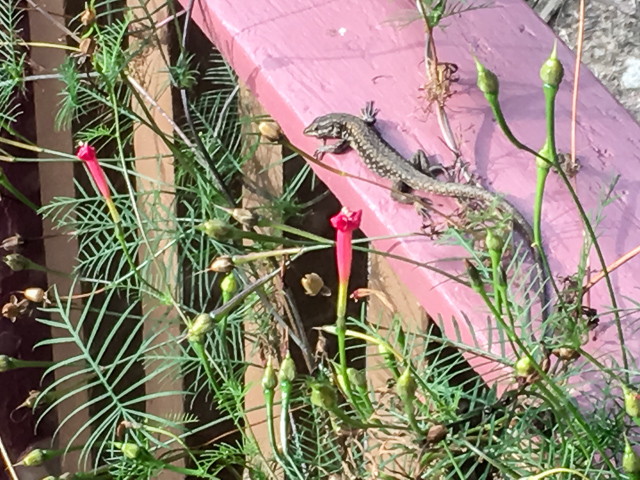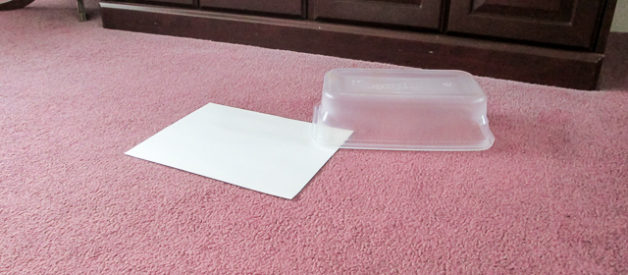April 30, 2020
A Lazarus lizard has taken up residence inside our house during the COVID-19 lockdown. It’s not that I don’t like lizards. I do. It’s just that Bonnie and I prefer to enjoy them in their natural habitat. Maybe our guest thinks it has to stay 14 days so it doesn’t infect its buddies. But we watch press briefings every day and we’ve heard nothing about any lizards catching the virus.
Bonnie first spotted it in the bedroom, right before it scooted under the closet door. Next it appeared in the living room. We chased it across the room with a clear storage container, but whenever the container hit the carpet, the lizard was long gone. The last time we saw it, it fled behind the entertainment center. We still hope to catch it. If we are successful, our resident reptile will have to do its social distancing outside.
We left the container at the last sighting, along with a piece of cardboard to slide underneath if we get lucky. We don’t want to grab the little guy and pull off its tail. We prefer to catch and release—all in one piece.
Lazarus lizards possess a defense mechanism called autotomy, the ability to detach their tails if a predator attacks. That’s what happened the one time I got lucky enough to snag one. It ran off and left me holding its wiggling tail. The kid in me thought this was really cool. (I wasn’t the perfect child.) The adult was mostly sad that our reptile had sacrificed its main defense, despite the fact I wasn’t a predator. Shucks, I didn’t even have a grudge against it. Fortunately, though, they can grow that appendage back.
For being a non-native species these lizards are doing pretty well, even if they occasionally lose a tail. They came to the Cincinnati area, it appears, as a result of another catch and release. The story is that the stepson of Fred Lazarus III (thus the name Lazarus lizard) captured somewhere between six and ten common wall lizards in northern Italy on a family vacation. He was evidently about six to ten times quicker than me. He then released them at his family’s home on Torrence Court in Hyde Park.
In the nearly 70 years since Mr. Rau brought the wall lizards over, their population has exploded. They have migrated to northern Kentucky and even to southwest Indiana. The climate in this area, though a bit colder, is similar to northern Italy. In freezing temperatures the transplanted lizards huddle underground (or in cozy living rooms). They surface in the spring to sun-warmed, rocky areas. If you see one, there are probably a dozen nearby.
I took a picture of one of our scaly friends through the back door window in the fall of 2018. I’m sure it was waiting for a bug crazy enough to try and get nectar from one of the pretty little cypress flowers. I attempted to get a more current photo, but they are just too quick. The other day I sneaked up on one and got fairly close, but at the last second it dodged into a large crack in our foundation. I peered into the gap and saw it had turned in its safe place to face me. I could swear it was grinning. I just grinned back.
We haven’t gone out much for quite a few weeks now. However, it sounds like the governor may begin releasing us soon for minimal activities. Until then, Bonnie and I and our little visitor should be fine—and hopefully each of us still all in one piece.




Elainek
April 30, 2020I’ve enjoyed your recent posts and have passed them on to my friends. We have more lizards than ever in Newport. It’s so fun to watch them. I’ve wondered if our mild winters the past couple of years have allowed them to multiply. Take care and stay safe. Elaine Kerley
CW Spencer
May 1, 2020Thanks, Elaine. I’ve noticed more lately as well. They are doing pretty well. According to Joe Boggs of Ohio State University Extension, “you will find European wall lizards listed among the names of native reptiles protected by law in Ohio, a rare achievement for a non-native animal.”
You and your family take care too. CW
Dolores R. Birkle
May 1, 2020I have joined you. I, too, have had a lizard visit in the house! I threw a bowl over him and he left me a piece of his tail. Mark, my son, rescued me after several hours that the lizard spent in the bowl trap and said that the lizard was perfectly harmless. Nevertheless I choose to be lizard free!
Dolores B
CW Spencer
May 2, 2020Hi Dolores, I’m glad you caught it. Ours could be outside itself by now. This old house has a lot of lizard-size escape (and reentry) cracks in the foundation.
Take care! CW